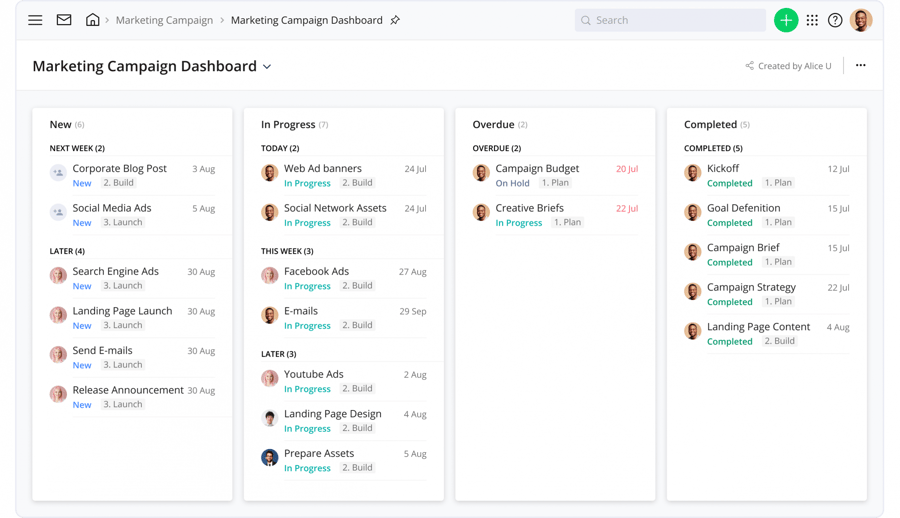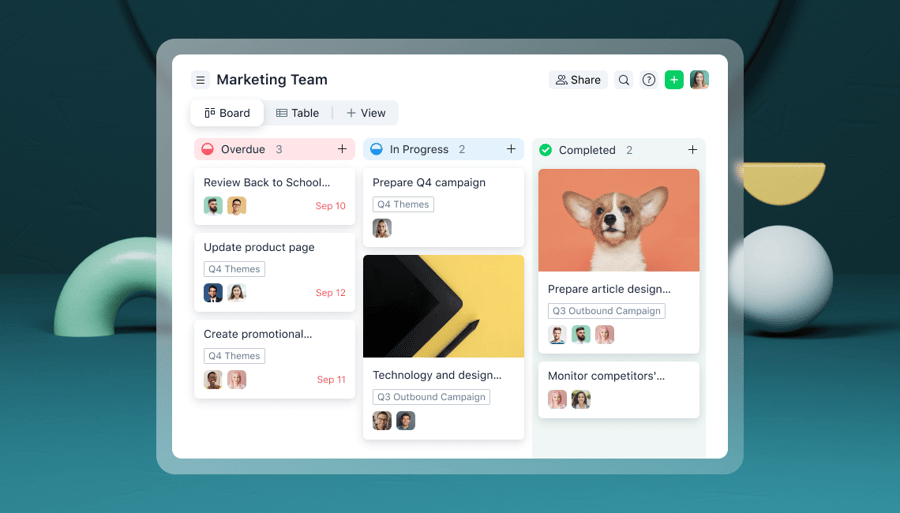Key takeaways:
- What is push marketing? This is a strategy focused on promoting products to consumers at the point of purchase, aiming for immediate sales and brand exposure.
- What is pull marketing? This is a strategy that encourages consumer demand and seeks to build long-term interest, usually for unique products.
- What are the key differences between push and pull marketing? Push targets existing demand for quick sales; pull builds awareness and interest over time.
- What role does consumer demand play? Strong demand favors push marketing; identified needs or new markets suit pull marketing.
- How can Wrike assist marketing strategies? Wrike helps plan, execute, and manage both push and pull campaigns efficiently with tools like Gantt charts and dashboards.
Planning your strategy for next quarter and not sure which direction to go in? In this article, we’re analyzing push vs. pull marketing so you can make the best possible decision. Learn more about what they are, how they are used, and the main difference between push and pull marketing. We’ll also go over some push vs. pull marketing examples and provide templates you can use to create winning marketing content.
What is push marketing?
All advertising can be classified into two broad categories: push and pull. On the one hand, push advertising aims to push products towards specific customers, while pull advertising focuses on the right people at the right time.
Push marketing, specifically, is a strategy managers use to promote their products to consumers. The goal of push marketing is to get the products seen by the consumers at the point of purchase. Exposure is the north star for this marketing plan. This can be accomplished through many different channels, including social media, standard mail, or in stores.
Although many companies try to build long-term relationships with their customers alongside this strategy, push marketing focuses on acquiring an immediate sale. That’s why it’s great for increasing sales volume and improving brand loyalty.
Push marketing can be applied to both B2C and professional services spaces. For example, in the B2B space, a manufacturer or wholesaler may try to convince a retail outlet to stock its product by including samples at an in-person marketing demonstration.
Although push marketing seems like the best option on paper, marketing managers should be cautious about making this their only approach. If a company decides to spend a huge sum on advertising, they can easily lose money if their customers ignore their messages.
Because push marketing doesn’t focus on building relationships, major drivers of sales, such as repeat business, aren’t a direct result of this campaign type. In other words, using push marketing as your only strategy could lead to missed opportunities.
On the other hand, push marketing is most successful when marketing campaigns promote goods and services that are already in demand.
Overall, push marketing is a great way to create immediate results and make a strong impression on potential customers. It eliminates the need for branding and promotes a new product quickly. Its temporary effects attract new customers even though it can be expensive and the results are often not long term.
Before you get started on a push marketing plan, your team should first gather information on the potential customers that you’ll be pushing the advertisements out to. Afterward, marketers can use this data to choose which platform or platforms they’ll focus on. From there, they’ll be able to create a powerful message that appeals to the right demographic and is highly effective for the marketing channel they plan to use.
What is pull marketing?
Pull marketing is a strategy that focuses on increasing the number of consumers who want to buy a particular product. It often involves convincing a consumer to actively seek a product in order to get retailers to stock it.
Brands that use pull marketing will reach out to consumers through a direct marketing campaign. The consumers then go to a retailer and purchase the product. This allows the producer to both sell the product and fill stock according to the consumer’s demand.
This strategy typically works best when the lead time is long enough for consumers to compare alternatives. This allows them to make a purchase without being pressured into a hasty decision. It also means companies must convince consumers that they should buy the product they see advertised.
The advantage to consumers is that they won’t have to settle for whatever product is in stock elsewhere simply because it is available. Instead, they’ll see the real value of your goods or services through your pull marketing strategy and are more willing to make the effort and reinvest long term if the proposition is strong enough.
There are many ways to reach customers through pull marketing, all of which aim to build excitement for a product or a company.
With pull marketing, a company can promote a product before it is available for purchase. It saves them money by reducing the number of units they produce before the product launches. In the best case scenario, the demand for a product will exceed the supply when pull marketing is used.
Most people are unsure of the differences between push vs. pull marketing. But they should also be asking what the differences are between pull marketing and regular marketing.
A pull marketing campaign is different from a traditional advertising campaign. Instead of focusing on a specific product or service, this strategy starts with analyzing the company’s goals and market potential. While both methods may analyze market research data, a pull marketing campaign places a greater emphasis on generating new interest.
Pull marketing is especially important for products that are completely unique in some way. Whether it’s a never-before-released trademark doll or a rare kitchen gadget, pull marketing is best used to reach new or underserved markets.
Word-of-mouth excitement and attracting plenty of customers is the name of the game with push marketing. This excitement should last across various stages of a product’s life cycle, selling out in stores or surpassing user capacity whenever possible.
Key differences between push and pull marketing
At first glance, push vs. pull marketing seems to be about exact opposites. But in reality, they do overlap. We’ve outlined the primary characteristics of each and how they look when applied in real life.
- Demand: Push marketing works well with products people are already familiar with or have an interest in. Pull marketing is effective for selling something people may have never heard of before and for creating demand where there was none or little to begin with.
- Length of time: Push marketing focuses on short-term sales, whereas pull marketing may take longer to establish.
- Product type: Pull marketing products are typically one of a kind in some way and may require telling audiences exactly what they are. Push marketing products are familiar to audiences and usually require little to no comparison shopping.
- Goal: Push marketing aims to make a sale immediately, whereas pull marketing builds an audience over time and often from scratch.
- Cost: Both types of marketing campaigns are what you make of them. They both may use similar channels but reach different audiences. It truly depends on the product and who you’re trying to reach.
In a nutshell: the differences between push and pull marketing primarily revolve around the brand’s relationship to the audiences they’re targeting and the sales goals they are trying to reach.
Push and pull strategy examples
Amazon is a great example of a company that uses both push and pull marketing strategies to make a profit.
First, its warehouses are strategically placed close to major cities and metropolitan areas. This makes Amazon a pure push company when it comes to selling its products because their service meets customers where their demand is.
At the same time, they use a pull strategy to promote third-party sellers with tools such as retargeting ads that entice users to go back onto the site and complete their purchase.
Both are highly effective. Without their warehouses, Amazon would have fewer sellers since space is often an obstacle for brands with physical inventory, which could deter wannabe businesses from the site. And without promoting their sellers’ products, they wouldn’t see any profit from their sales.
How to choose between push or pull marketing
There are two things to consider as you choose between push or pull marketing. The first is demand. Is there already strong demand for what you do or offer? Do you know how and where to reach customers at the point of sale, whether online or in person, for this specific product? If you can confidently answer those questions, then push marketing is the strategy for you.
On the other hand, is word-of-mouth marketing an important part of your strategy? Do you know if your offer fulfills a need that your customers don’t realize they have or don’t yet know your solution is the best possible option? If yes, then pull marketing is your best bet.
How to set up your marketing strategy with Wrike
Wrike is a project management tool marketers use to plan and execute their strategies.
Wrike users plan and launch hundreds of digital marketing campaigns across various platforms and languages. Planning and executing these campaigns can be challenging, even for those who already know a thing or two about push vs. pull marketing. That’s where Wrike’s template comes in.
This template is built to help marketing teams organize and execute digital marketing campaigns. To begin, break down your campaign into phases. Create tasks that must be completed within each phase and assign them to your team. Each task can be assigned to a specific member of your team. These tasks can be easily categorized into various categories and can be deleted or renamed as needed.
Next, track progress with our interactive Gantt chart and export reports for review. Because Wrike is secure, you can safely communicate and share data with other stakeholders and managers to get feedback on performance. Not only is this useful for keeping track of complex push and pull marketing campaigns, but it’s also helpful for managing different marketing projects at the same time.
Most marketers utilize both push and pull marketing strategies but have the same team members working on both. Having your projects managed all in one place makes it easier to see progress, communicate tasks, and keep everyone on the same page despite all the different strategies in play.
In addition to task assignments, Wrike also offers visual Gantt charts to help users better understand the big picture. The Gantt chart view shows the project’s overall plan and all the tasks in its dynamic timeline. It can help you spot delays and maximize your chances of meeting your deadlines.
To further maximize visibility, this template comes with a pre-configured dashboard that shows campaign progress, which includes unassigned tasks and overdue tasks. It also includes a variety of predefined widgets to help you keep track of all your campaign data.
As you go about creating materials for your push and pull campaigns, Wrike allows you to store campaign assets and label them in files that display in chronological order so you can manage them better.
In addition to managing campaigns, Wrike helps both push and pull marketers maximize the efficiency of daily operations.
The role of marketing operations management is a critical one, as organizations are now more focused on collecting and managing large amounts of data. This often involves planning, implementing, and reporting on various analytical platforms.
Wrike is the ideal companion for analytical marketing teams, who love the ability to manage all of their campaigns. Whether you use our premade template or a custom one, your marketing operations team can execute at new levels of efficiency.
In conclusion
The debate over the pros and cons of pull and push marketing has been ongoing for decades. Both strategies are often used by marketing professionals as part of their company’s marketing plans. Whichever you choose, make sure you partner with a solution that offers the level of organization, visibility, and attention to detail that Wrike does through features such as Gantt charts and dashboards that make even the most complex strategies manageable. Start your two-week free trial with Wrike today.









